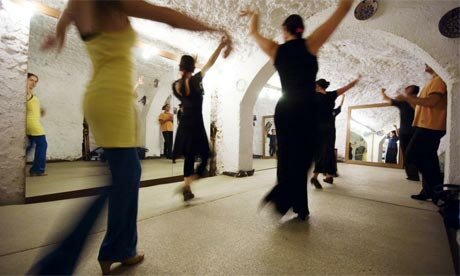“Musica, musica!” It is a lazy Sunday in Granada, Andalucia, and in the autumn sunshine two young girls twirl and flounce and flap their dresses at an old man leaning against a restaurant wall, beer in hand and an accordion on his lap. With a smile he obliges, picking up the bellows – the cue for a small crowd of diners in Plaza de San Miguel Bajo to clap along.
In this pocket of southern Spain, musica is clearly in the blood – as well as the feet, hands and vocal chords. And I’m hoping to get it into mine.
I dabbled in flamenco on a visit to Seville in April, where I took a couple of lessons, visited the excellent Museum of Flamenco Dance, and got swept up in the drama of it all at the nightly shows. A natural dancer I’m not, but I found the fiery foot-stamping and clapping bits great fun, and a good form of release. But it wasn’t until an impulsive get-me-out-of-here internet surf one dreary October afternoon that I discovered you can learn just this bit of the flamenco – known as compas – without any need for dancing skills. Compas means rhythm, or beat, and is one of the elements uniting the three basic forms of flamenco expression: guitar, voice and dance. You learn how to clap and stamp your feet to the rhythm of flamenco. Within the hour I’d signed up for a compas rhythm course in Granada. An entire week of clapping and stamping … what’s not to like?
After barely a few hours in the Albaicin, Granada’s Moorish quarter, I had washed down seafood tapas with a couple of glasses of crisp Rioja, been wafted along narrow whitewashed streets on clouds of orange and jasmine scent, and got lost more times than I can remember. The flamenco and language school where I enrolled, is excavated into a hill that separates the Albaicin from Sacromonte, the city’s peculiar cave district. Settled by craftsmen and gitanos (Romany Gypsies), the natural grottoes now house cave hotels and restaurants, cave museums, cave apartments for rent, cave bars or clubs (known as tablaos ) and cave houses (casas cueva). Sacromonte has long been a hotbed of flamenco expression, and it is used by locals, gitanos, payos (non-Gypsies) and visitors alike. Its tiny sugar-cube exterior hides a warren of modernised, sound-proofed studios, classrooms and vine-covered terraces.
In the week’s timetable, which ran the gamut of flamenco disciplines from compas (rhythm) and guitar to various levels of dance, as well as Spanish classes, there were spaces on the “Spanish for beginners” course, and a handful of us signed up. Although Spanish isn’t essential, a smattering certainly helps. And according to Jorge, our compas teacher, Spanish is ” muy importante “, if only to understand which particular flamenco style, or palo , we were supposed to be clapping.
Compas is marked by the palmas (clapping) and palmeras (foot-tapping of the percussionists). The guitarists rely on it: without the palmeras, the dance topples like dominoes. Beginners are expected to be able to distinguish between a handful of flamenco styles by the end of the course, and maybe even use them to express states of emotion.
With Jorge pounding the cajon, the wooden drumbox, and all eyes on our rhythm sheets, we learned to clap each beat according to the marks: silencio (silence), palmada (clap) and palmada con acento (clap/tap louder). Beats were slowed down or speeded up according to which style we were clapping. It was intense, and with only an hour and a half in class every other day, practice was everything.
“No discos or boys this weekend,” scolded Jorge, at the beginning of our second lesson. “Palmas has to be perfect or the show stops!”
Tempting though it was to linger at the idyllic school with its communal buzz, there was the World Heritage Albaicin on the doorstep. When not clapping, learning Spanish vocab or luxuriating on one of the school’s sun-soaked terraces, we were in the hushed pools of the hammam, breakfasting on tostados drenched in olive-oily tomato in Plaza Larga, or gazing at the Alhambra palace from one of the many miradors.
In the evenings we watched flamenco shows in smoky cave bars. My final night was reserved for the legendary zambra, performed at a tablao near the school. Loosely based on a Gypsy wedding, this flamboyant dance is the ultimate expression of the area. The performance was so-so until the eldest of the three women, a heavily set gitano in her mid- to late-50s, strutted on stage. Tossing her heels like a frisky colt, she didn’t just dance the zambra, she seemed to embody it, the emotion showing in pained, contorted expressions. I was in the front row, and by the time she finished her eyeliner was running down her cheeks – and my glass of Rioja had been chased with splinters and sweat.
By the end of the week, not only could I tell a good flamenco from a mediocre one, I could clap a fandango, a bulerias, a solea and a seguiriya by reading a sheet of, well, crazy clapping music. That’s progress enough for me.
• GoLearnTo.com (0844 502 0445) offers more than 1,000 learning holidays in 30 countries. A one-week Flamenco Compas Rhythm Course in Granada costs from pounds 64. A room in an apartment costs from £112 for one week (bookable through GoLearnTo). Ryanair.com flies Stansted to Granada from £19.99 one-way exc tax
This article featured in The Guardian newspaper today written by Teresa Machan







 Designed by
Designed by